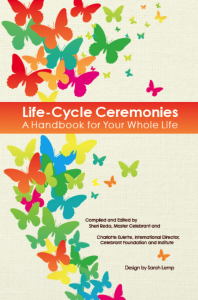We live in iconoclastic times. Contemporary Americans acknowledge very few rules that can’t be broken, very few assumptions that cannot be questioned, and very few traditions that cannot be opened up or reconfigured. Our behavioral freedom is nearly boundless . . . and as a result we sometimes struggle with a sense of rootlessness.
Often, I talk with clients who assume that isolation is the price they pay for freedom from intolerable strictures around faith, family, or community. Happily, it’s a false assumption. Though we humans are social beings, we need not sacrifice our individual perceptions, opinions or goals in a quest to fit in. In fact, we needn’t “fit in” at all. What human beings need is not conformity, but belonging—and we can structure belonging in any way we like. That’s the function that ceremonies perform for us. Ceremonies enact a shift so that it can be seen, heard, and felt in the bones.
pay for freedom from intolerable strictures around faith, family, or community. Happily, it’s a false assumption. Though we humans are social beings, we need not sacrifice our individual perceptions, opinions or goals in a quest to fit in. In fact, we needn’t “fit in” at all. What human beings need is not conformity, but belonging—and we can structure belonging in any way we like. That’s the function that ceremonies perform for us. Ceremonies enact a shift so that it can be seen, heard, and felt in the bones.
Not too long a go, ceremonies were boilerplate affairs, and participants plugged themselves in, fulfilling long-enshrined actions that placed them into heavily structured roles. After a short period in which people simply rejected weddings, couples began to understand that they could structure their weddings to express their personal relationships and their values for a future together.
Today, wedding ceremonies are an excellent example of structures that create belonging and—affirm a life passage—among people who are varied and who may, in some cases, remain complete strangers to one another. They ground participants in action, and they embody transition, but they can be shaped to express the individual transition of each particular wedding.
In the same way, every milestone moment can be grounded through ceremony. A move into a new home can be nerve-wracking and strange—until we experience the joy of creating new patterns among guests who celebrate that we have a home base. A new child in the home is disorienting—until we create a ceremony to express both our fears and our hopes for the future. A retirement can feel alienating—until the alienation is soothed though a ceremony that sums up past achievements and brings them, in a new form, to retired life.
As any parent of a toddler will tell you, everyone needs structure. But we have it within us to create the structures we need. Ceremonies, by their varied structures, create a venue for embodied experience. They support out transitions by incorporating the changes into our lives as we live them. Turns out that standing on ceremony is not an outdated habit. It’s one of the best ways ever to get grounded.
Recent Posts
-
Can Energy Clearing Help Me Resolve Fear or Anger?
March 18, 2025 -
Does energy regulation mean opening chakras entirely?
February 18, 2025 -
Winter Solstice: The Big Go Within: Diving into Darkness
December 4, 2024

E-Newsletter Sign Up
© 2025 Heartwood. All rights reserved.
